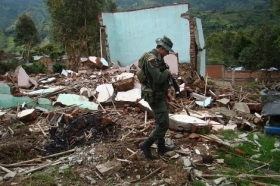A newly published report states that the FARC stepped up actions in 2011, in no small part due to their alliance with rebel cousins the ELN, while despite mass arrests the new generation paramilitary groups appear relatively intact.
Bogota-based security think-tank Corporacion Nuevo Arco Iris (CNAI) published its fourth annual review (pdf) of the Colombian conflict during 2011, painting a grim picture of the expansion of the most powerful criminal syndicates, the Revolutionary Armed Forces of Colombia (FARC), the neo-paramilitary groups which the government calls “bandas criminales” (BACRIMs), and the National Liberation Army (ELN).
According to CNAI’s count, the guerrilla group of the FARC increased its activity by 10 percent in 2011. The rebel group committed 2,148 offensive actions, during which 449 members of the security forces were killed and another 1,786 injured.
However, it should be noted that CNAI counts the use of anti-personnel mines by the FARC as an offensive action. These alone accounted for 521 attacks in 2011, the report says. Another Colombian think-tank, Fundacion Ideas Para La Paz, argued last year that the FARC’s use of anti-personnel mines is a defensive strategy, and as such not should not be counted as an “offensive” action. Mines are often placed in front of advancing military patrols and used to trigger ambushes. Even discounting the use of anti-personnel mines, the evidence still points to increased activity by the FARC. CNAI counted 614 hit-and-run attacks (“hostigamientos”) and 421 combats.
More telling is the number of casualties in the security forces the CNAI counted as the result of FARC actions. 2,235 military and police officials were injured or killed in 2011, meaning that there have been over 6,000 casualties in the past three years, the report says. This is compared to the 1,768 deaths and·5,134·wounded registered between 2005 and 2007, according to statistics from the Colombian Ministry of Defence.
It appears that these trends observed during 2011 may continue into 2012. The FARC’s new commander, Rodrigo Londoño Echeverry, alias “Timochenko,” appears set on continuing the strategy laid out by his predecessor, Guillermo Leon Saenz Vargas, alias “Alfonso Cano,” killed in November last year. Cano’s “Plan Renacer” and “Plan 2010” documents revised the FARC’s overall strategy, emphasizing small-scale attacks against the security forces and the widespread use of explosives.·This still appears to be the blueprint under Timochenko, with three car bombs registered in January alone, leaving at least 18 victims, with another 14 devices deactivated across Colombia in the space of less than a week.
Timochenko also appears set to continue, and is developing, Cano’s policy of working alongside the ELN, rather than fighting them. This has allowed the ELN, along with income from drug trafficking, to resurge in some parts of Colombia, particularly border departments with Venezuela like Norte de Santander and Arauca, and has seen joint actions between the two groups. According to CNAI, the smaller ELN carried out 217 offensive actions, and were responsible for 10 percent of the kidnappings registered last year.
Since the 2008 death of the FARC’s founder, Manuel Marulanda, alias “Tirofijo,” Cano and now Timochenko have both put the fratricidal war with the ELN behind them. In some parts of the country, the FARC-ELN ceasefire has developed into a real alliance. This could have significant implications for the development of the Colombian conflict, if the ELN and FARC begin sharing resources and manpower, and planning joint attacks against the security forces.
CNAI also commented on the expansion of the BACRIMs, the successor groups to paramilitary organization the AUC. The BACRIMs are now active in about one-sixth of Colombia’s territory, and have replaced the rebel groups as the primary instigators of violence and displacement in the country, the report stated.
Similarly to its previous reports, CNAI criticized the government for painting a false picture of how numerous the BACRIMs actually are. In its 2008 study, the foundation estimated there were 10,800 members of the BACRIMs, a number which the government contested. However, the report asked, if Police Director General Oscar Naranjo claims that 13,000 members of the BACRIMs have been arrested since 2006, “why aren’t these illegal armed groups finished with?” The answer to that is either that these groups have an impressive ability to recruit new members, or more likely, those arrested were not core BACRIM members.
Naranjo contested the report’s claims, stating that the BACRIMs are “going through one of their worst moments,” given the removal of leaders like Maximiliano Bonilla, alias “Valenciano,” and Juan de Dios Usuga, alias “Giovanni,” as well as the demobilization of one of the first BACRIMs to emerge, the Popular Revolutionary Antiterrorist Army of Colombia (ERPAC).
The CNAI conclusion that these post-paramilitary groups are now Colombia’s primary security threat is in line with the government’s assessment. Naranjo himself stated in 2011 that the BACRIMs are the biggest threat to national security. Police statistics, as well findings by other think-tanks like Human Rights Watch and Colombian group INDEPAZ, have all argued that the BACRIMs are now the primary drivers of violence in the country.
The problem is that even as the government recognizes the BACRIM threat, and has acknowledged that the security forces have lost momentum against the FARC, they have yet to re-jig their approach to the armed conflict. So far, events in 2012 show that this could be another year of stepped-up actions from both the rebels and the BACRIMs. However sources in the Ministry of Defense told InSight Crime that there was a policy review going on at the moment and that there were plans for the security forces to make another “strategic leap” in 2012.

